Assignment on Global Strategy
VerifiedAdded on 2021/02/19
|9
|3362
|98
AI Summary
Contribute Materials
Your contribution can guide someone’s learning journey. Share your
documents today.
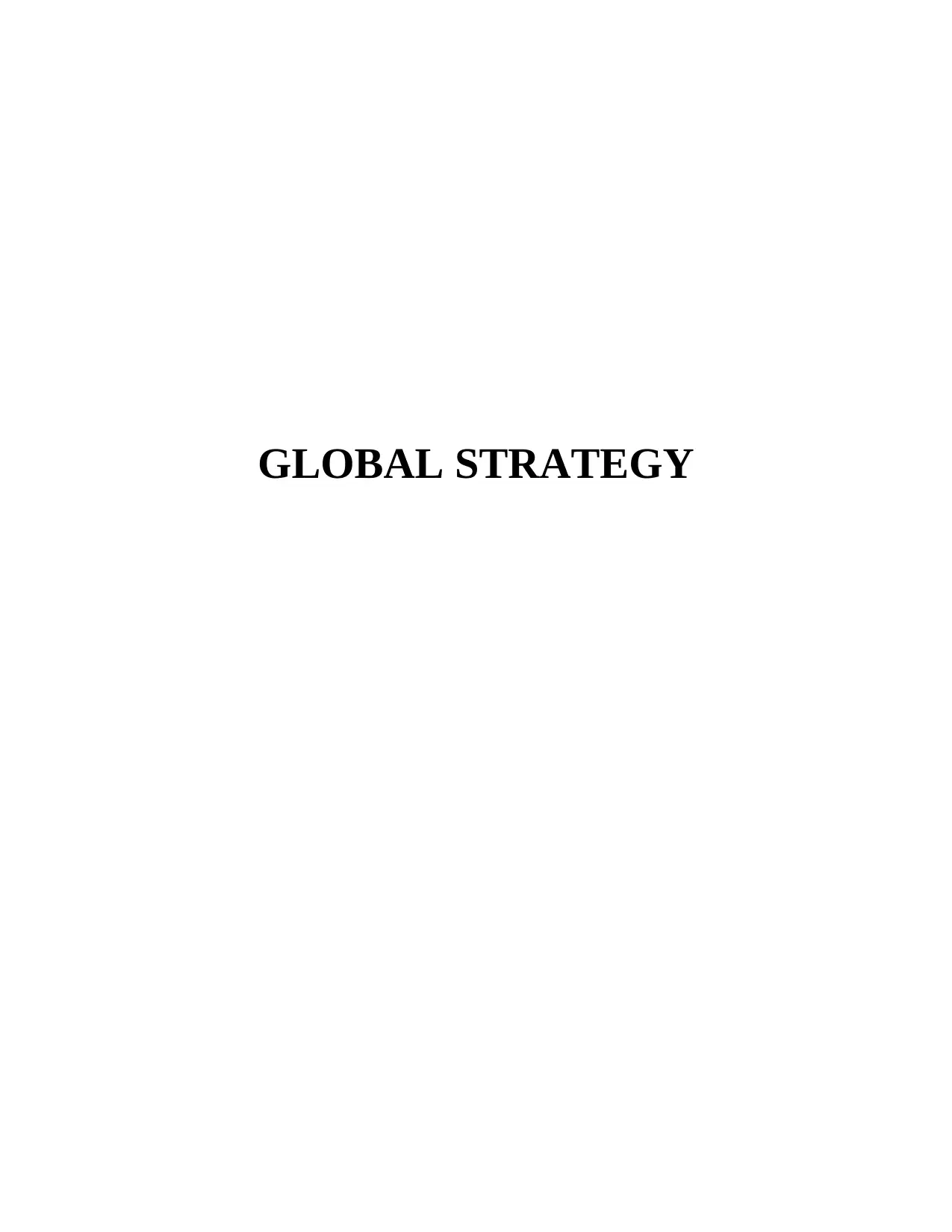
GLOBAL STRATEGY
Secure Best Marks with AI Grader
Need help grading? Try our AI Grader for instant feedback on your assignments.
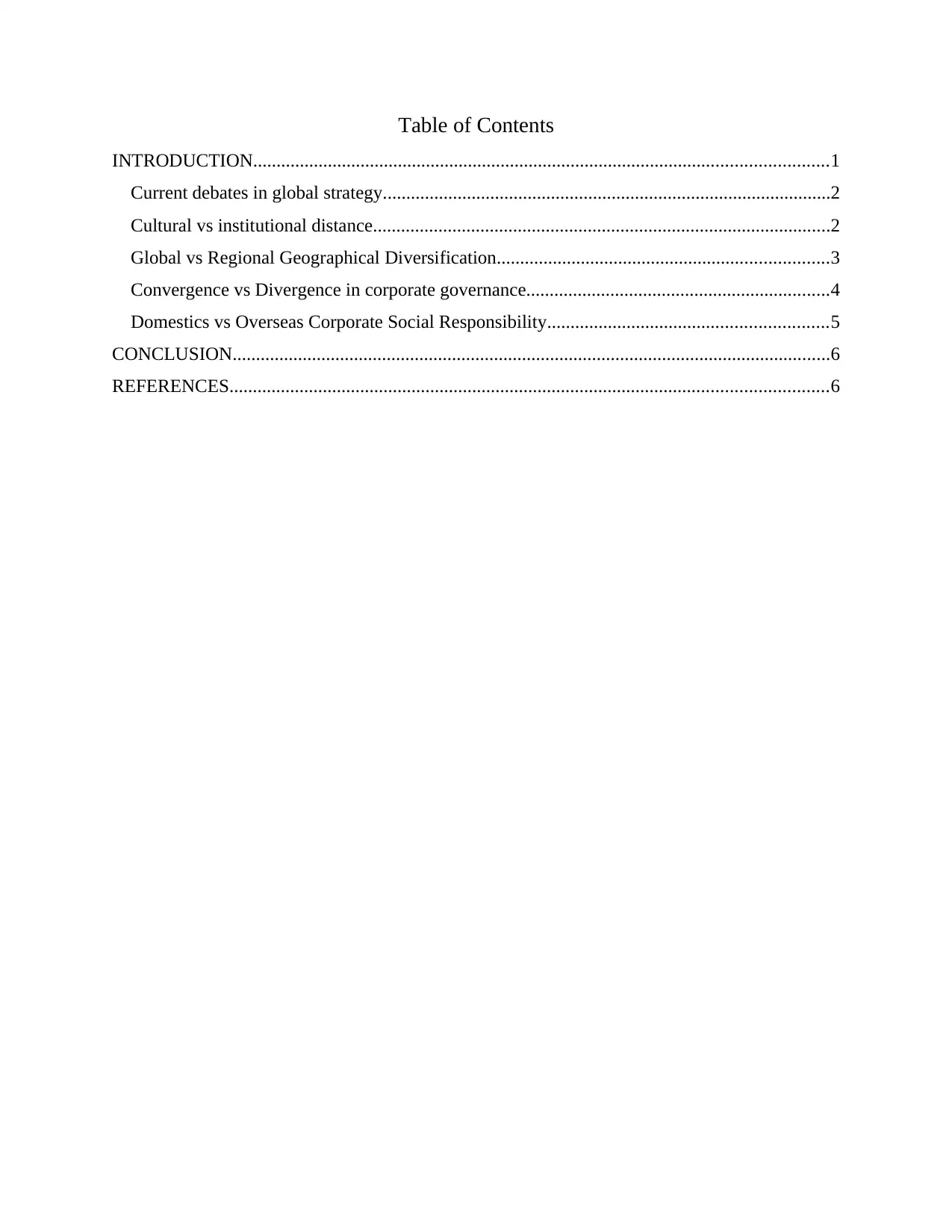
Table of Contents
INTRODUCTION...........................................................................................................................1
Current debates in global strategy................................................................................................2
Cultural vs institutional distance..................................................................................................2
Global vs Regional Geographical Diversification.......................................................................3
Convergence vs Divergence in corporate governance.................................................................4
Domestics vs Overseas Corporate Social Responsibility............................................................5
CONCLUSION................................................................................................................................6
REFERENCES................................................................................................................................6
INTRODUCTION...........................................................................................................................1
Current debates in global strategy................................................................................................2
Cultural vs institutional distance..................................................................................................2
Global vs Regional Geographical Diversification.......................................................................3
Convergence vs Divergence in corporate governance.................................................................4
Domestics vs Overseas Corporate Social Responsibility............................................................5
CONCLUSION................................................................................................................................6
REFERENCES................................................................................................................................6
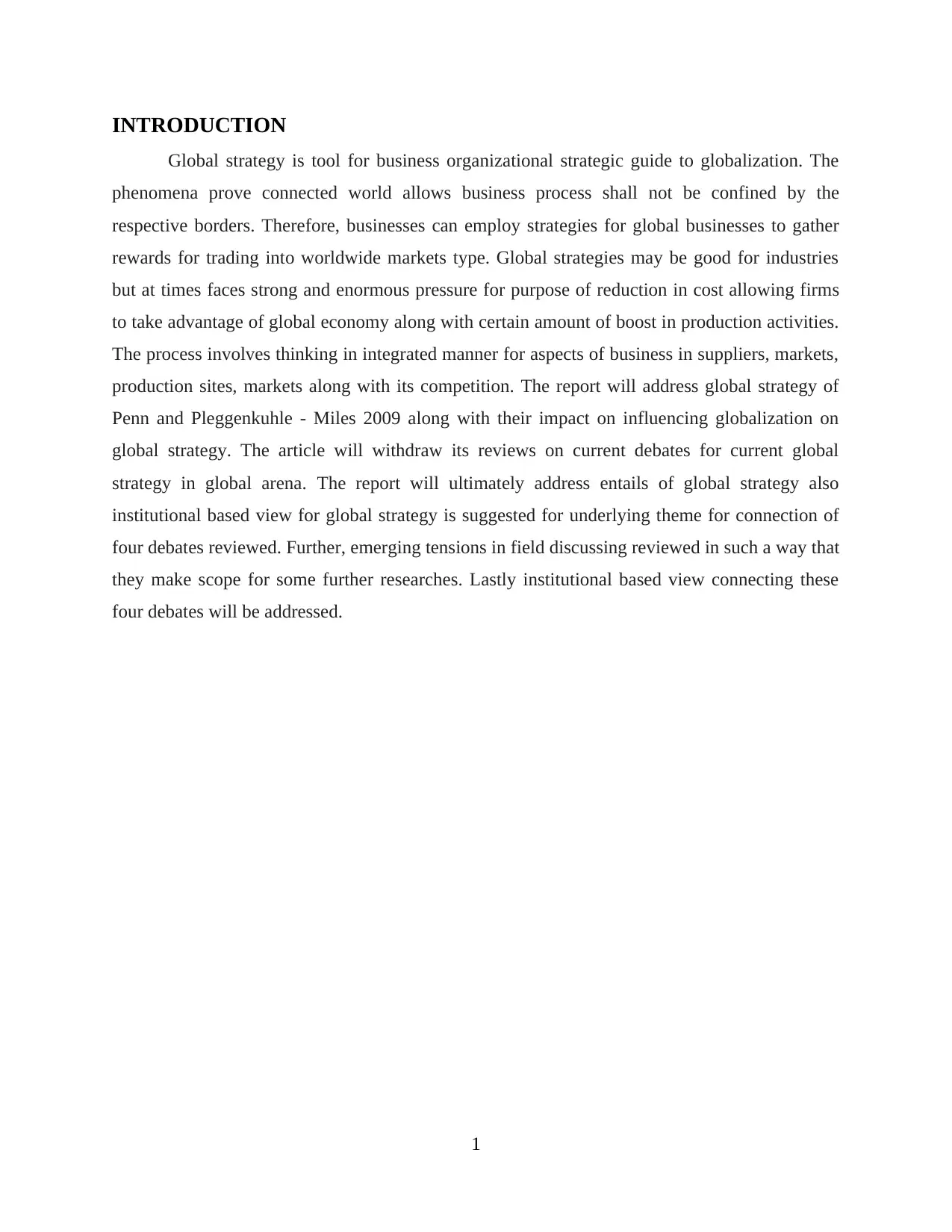
INTRODUCTION
Global strategy is tool for business organizational strategic guide to globalization. The
phenomena prove connected world allows business process shall not be confined by the
respective borders. Therefore, businesses can employ strategies for global businesses to gather
rewards for trading into worldwide markets type. Global strategies may be good for industries
but at times faces strong and enormous pressure for purpose of reduction in cost allowing firms
to take advantage of global economy along with certain amount of boost in production activities.
The process involves thinking in integrated manner for aspects of business in suppliers, markets,
production sites, markets along with its competition. The report will address global strategy of
Penn and Pleggenkuhle - Miles 2009 along with their impact on influencing globalization on
global strategy. The article will withdraw its reviews on current debates for current global
strategy in global arena. The report will ultimately address entails of global strategy also
institutional based view for global strategy is suggested for underlying theme for connection of
four debates reviewed. Further, emerging tensions in field discussing reviewed in such a way that
they make scope for some further researches. Lastly institutional based view connecting these
four debates will be addressed.
1
Global strategy is tool for business organizational strategic guide to globalization. The
phenomena prove connected world allows business process shall not be confined by the
respective borders. Therefore, businesses can employ strategies for global businesses to gather
rewards for trading into worldwide markets type. Global strategies may be good for industries
but at times faces strong and enormous pressure for purpose of reduction in cost allowing firms
to take advantage of global economy along with certain amount of boost in production activities.
The process involves thinking in integrated manner for aspects of business in suppliers, markets,
production sites, markets along with its competition. The report will address global strategy of
Penn and Pleggenkuhle - Miles 2009 along with their impact on influencing globalization on
global strategy. The article will withdraw its reviews on current debates for current global
strategy in global arena. The report will ultimately address entails of global strategy also
institutional based view for global strategy is suggested for underlying theme for connection of
four debates reviewed. Further, emerging tensions in field discussing reviewed in such a way that
they make scope for some further researches. Lastly institutional based view connecting these
four debates will be addressed.
1
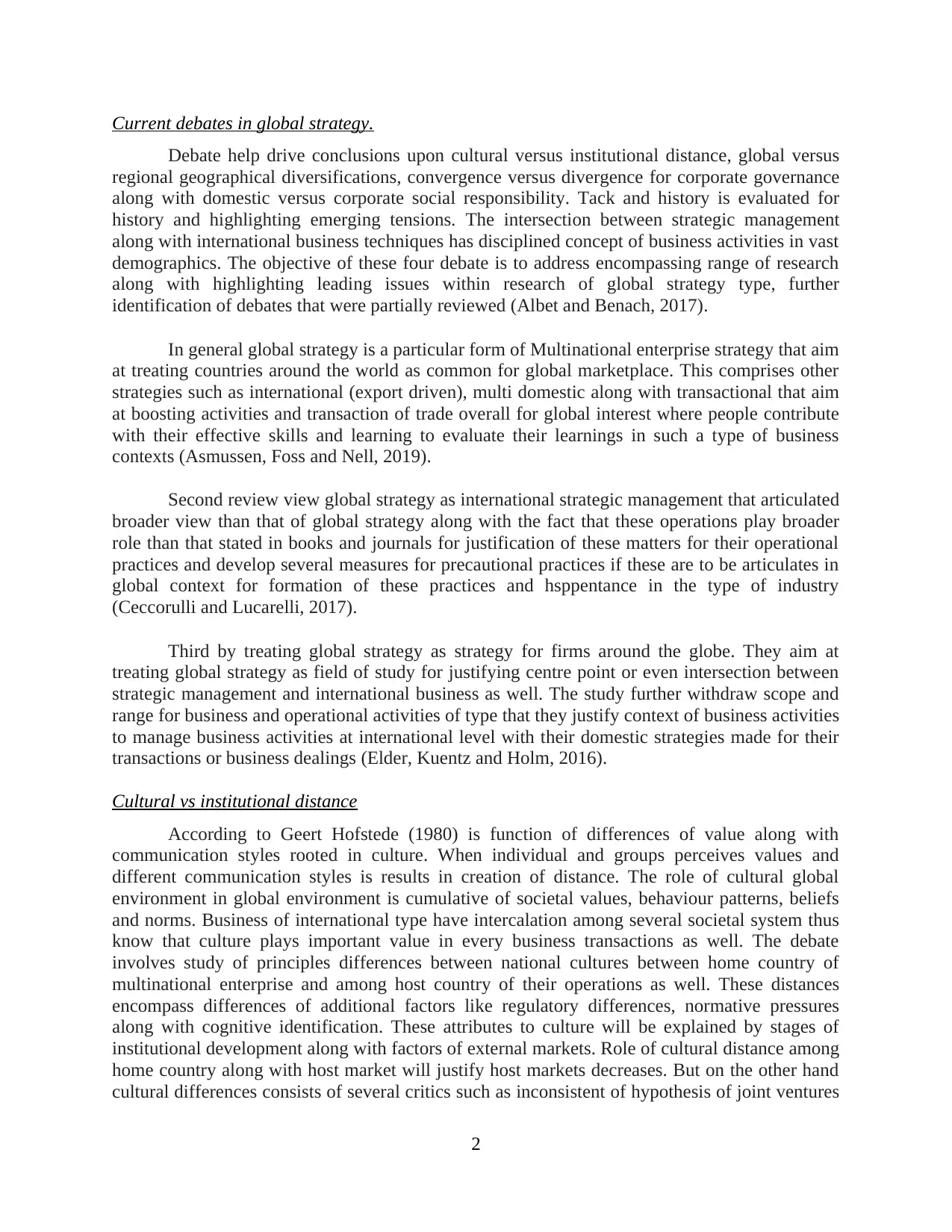
Current debates in global strategy.
Debate help drive conclusions upon cultural versus institutional distance, global versus
regional geographical diversifications, convergence versus divergence for corporate governance
along with domestic versus corporate social responsibility. Tack and history is evaluated for
history and highlighting emerging tensions. The intersection between strategic management
along with international business techniques has disciplined concept of business activities in vast
demographics. The objective of these four debate is to address encompassing range of research
along with highlighting leading issues within research of global strategy type, further
identification of debates that were partially reviewed (Albet and Benach, 2017).
In general global strategy is a particular form of Multinational enterprise strategy that aim
at treating countries around the world as common for global marketplace. This comprises other
strategies such as international (export driven), multi domestic along with transactional that aim
at boosting activities and transaction of trade overall for global interest where people contribute
with their effective skills and learning to evaluate their learnings in such a type of business
contexts (Asmussen, Foss and Nell, 2019).
Second review view global strategy as international strategic management that articulated
broader view than that of global strategy along with the fact that these operations play broader
role than that stated in books and journals for justification of these matters for their operational
practices and develop several measures for precautional practices if these are to be articulates in
global context for formation of these practices and hsppentance in the type of industry
(Ceccorulli and Lucarelli, 2017).
Third by treating global strategy as strategy for firms around the globe. They aim at
treating global strategy as field of study for justifying centre point or even intersection between
strategic management and international business as well. The study further withdraw scope and
range for business and operational activities of type that they justify context of business activities
to manage business activities at international level with their domestic strategies made for their
transactions or business dealings (Elder, Kuentz and Holm, 2016).
Cultural vs institutional distance
According to Geert Hofstede (1980) is function of differences of value along with
communication styles rooted in culture. When individual and groups perceives values and
different communication styles is results in creation of distance. The role of cultural global
environment in global environment is cumulative of societal values, behaviour patterns, beliefs
and norms. Business of international type have intercalation among several societal system thus
know that culture plays important value in every business transactions as well. The debate
involves study of principles differences between national cultures between home country of
multinational enterprise and among host country of their operations as well. These distances
encompass differences of additional factors like regulatory differences, normative pressures
along with cognitive identification. These attributes to culture will be explained by stages of
institutional development along with factors of external markets. Role of cultural distance among
home country along with host market will justify host markets decreases. But on the other hand
cultural differences consists of several critics such as inconsistent of hypothesis of joint ventures
2
Debate help drive conclusions upon cultural versus institutional distance, global versus
regional geographical diversifications, convergence versus divergence for corporate governance
along with domestic versus corporate social responsibility. Tack and history is evaluated for
history and highlighting emerging tensions. The intersection between strategic management
along with international business techniques has disciplined concept of business activities in vast
demographics. The objective of these four debate is to address encompassing range of research
along with highlighting leading issues within research of global strategy type, further
identification of debates that were partially reviewed (Albet and Benach, 2017).
In general global strategy is a particular form of Multinational enterprise strategy that aim
at treating countries around the world as common for global marketplace. This comprises other
strategies such as international (export driven), multi domestic along with transactional that aim
at boosting activities and transaction of trade overall for global interest where people contribute
with their effective skills and learning to evaluate their learnings in such a type of business
contexts (Asmussen, Foss and Nell, 2019).
Second review view global strategy as international strategic management that articulated
broader view than that of global strategy along with the fact that these operations play broader
role than that stated in books and journals for justification of these matters for their operational
practices and develop several measures for precautional practices if these are to be articulates in
global context for formation of these practices and hsppentance in the type of industry
(Ceccorulli and Lucarelli, 2017).
Third by treating global strategy as strategy for firms around the globe. They aim at
treating global strategy as field of study for justifying centre point or even intersection between
strategic management and international business as well. The study further withdraw scope and
range for business and operational activities of type that they justify context of business activities
to manage business activities at international level with their domestic strategies made for their
transactions or business dealings (Elder, Kuentz and Holm, 2016).
Cultural vs institutional distance
According to Geert Hofstede (1980) is function of differences of value along with
communication styles rooted in culture. When individual and groups perceives values and
different communication styles is results in creation of distance. The role of cultural global
environment in global environment is cumulative of societal values, behaviour patterns, beliefs
and norms. Business of international type have intercalation among several societal system thus
know that culture plays important value in every business transactions as well. The debate
involves study of principles differences between national cultures between home country of
multinational enterprise and among host country of their operations as well. These distances
encompass differences of additional factors like regulatory differences, normative pressures
along with cognitive identification. These attributes to culture will be explained by stages of
institutional development along with factors of external markets. Role of cultural distance among
home country along with host market will justify host markets decreases. But on the other hand
cultural differences consists of several critics such as inconsistent of hypothesis of joint ventures
2
Secure Best Marks with AI Grader
Need help grading? Try our AI Grader for instant feedback on your assignments.
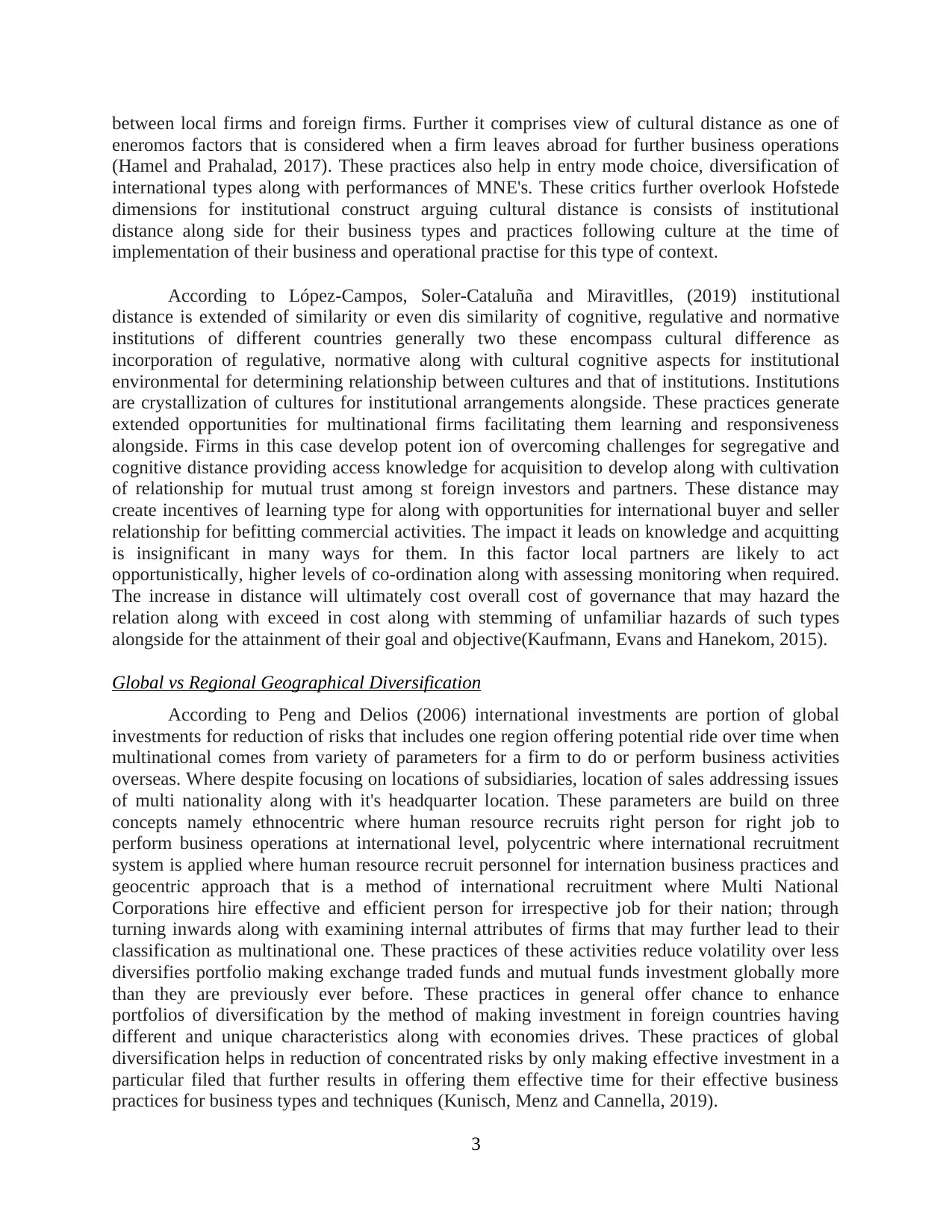
between local firms and foreign firms. Further it comprises view of cultural distance as one of
eneromos factors that is considered when a firm leaves abroad for further business operations
(Hamel and Prahalad, 2017). These practices also help in entry mode choice, diversification of
international types along with performances of MNE's. These critics further overlook Hofstede
dimensions for institutional construct arguing cultural distance is consists of institutional
distance along side for their business types and practices following culture at the time of
implementation of their business and operational practise for this type of context.
According to López-Campos, Soler-Cataluña and Miravitlles, (2019) institutional
distance is extended of similarity or even dis similarity of cognitive, regulative and normative
institutions of different countries generally two these encompass cultural difference as
incorporation of regulative, normative along with cultural cognitive aspects for institutional
environmental for determining relationship between cultures and that of institutions. Institutions
are crystallization of cultures for institutional arrangements alongside. These practices generate
extended opportunities for multinational firms facilitating them learning and responsiveness
alongside. Firms in this case develop potent ion of overcoming challenges for segregative and
cognitive distance providing access knowledge for acquisition to develop along with cultivation
of relationship for mutual trust among st foreign investors and partners. These distance may
create incentives of learning type for along with opportunities for international buyer and seller
relationship for befitting commercial activities. The impact it leads on knowledge and acquitting
is insignificant in many ways for them. In this factor local partners are likely to act
opportunistically, higher levels of co-ordination along with assessing monitoring when required.
The increase in distance will ultimately cost overall cost of governance that may hazard the
relation along with exceed in cost along with stemming of unfamiliar hazards of such types
alongside for the attainment of their goal and objective(Kaufmann, Evans and Hanekom, 2015).
Global vs Regional Geographical Diversification
According to Peng and Delios (2006) international investments are portion of global
investments for reduction of risks that includes one region offering potential ride over time when
multinational comes from variety of parameters for a firm to do or perform business activities
overseas. Where despite focusing on locations of subsidiaries, location of sales addressing issues
of multi nationality along with it's headquarter location. These parameters are build on three
concepts namely ethnocentric where human resource recruits right person for right job to
perform business operations at international level, polycentric where international recruitment
system is applied where human resource recruit personnel for internation business practices and
geocentric approach that is a method of international recruitment where Multi National
Corporations hire effective and efficient person for irrespective job for their nation; through
turning inwards along with examining internal attributes of firms that may further lead to their
classification as multinational one. These practices of these activities reduce volatility over less
diversifies portfolio making exchange traded funds and mutual funds investment globally more
than they are previously ever before. These practices in general offer chance to enhance
portfolios of diversification by the method of making investment in foreign countries having
different and unique characteristics along with economies drives. These practices of global
diversification helps in reduction of concentrated risks by only making effective investment in a
particular filed that further results in offering them effective time for their effective business
practices for business types and techniques (Kunisch, Menz and Cannella, 2019).
3
eneromos factors that is considered when a firm leaves abroad for further business operations
(Hamel and Prahalad, 2017). These practices also help in entry mode choice, diversification of
international types along with performances of MNE's. These critics further overlook Hofstede
dimensions for institutional construct arguing cultural distance is consists of institutional
distance along side for their business types and practices following culture at the time of
implementation of their business and operational practise for this type of context.
According to López-Campos, Soler-Cataluña and Miravitlles, (2019) institutional
distance is extended of similarity or even dis similarity of cognitive, regulative and normative
institutions of different countries generally two these encompass cultural difference as
incorporation of regulative, normative along with cultural cognitive aspects for institutional
environmental for determining relationship between cultures and that of institutions. Institutions
are crystallization of cultures for institutional arrangements alongside. These practices generate
extended opportunities for multinational firms facilitating them learning and responsiveness
alongside. Firms in this case develop potent ion of overcoming challenges for segregative and
cognitive distance providing access knowledge for acquisition to develop along with cultivation
of relationship for mutual trust among st foreign investors and partners. These distance may
create incentives of learning type for along with opportunities for international buyer and seller
relationship for befitting commercial activities. The impact it leads on knowledge and acquitting
is insignificant in many ways for them. In this factor local partners are likely to act
opportunistically, higher levels of co-ordination along with assessing monitoring when required.
The increase in distance will ultimately cost overall cost of governance that may hazard the
relation along with exceed in cost along with stemming of unfamiliar hazards of such types
alongside for the attainment of their goal and objective(Kaufmann, Evans and Hanekom, 2015).
Global vs Regional Geographical Diversification
According to Peng and Delios (2006) international investments are portion of global
investments for reduction of risks that includes one region offering potential ride over time when
multinational comes from variety of parameters for a firm to do or perform business activities
overseas. Where despite focusing on locations of subsidiaries, location of sales addressing issues
of multi nationality along with it's headquarter location. These parameters are build on three
concepts namely ethnocentric where human resource recruits right person for right job to
perform business operations at international level, polycentric where international recruitment
system is applied where human resource recruit personnel for internation business practices and
geocentric approach that is a method of international recruitment where Multi National
Corporations hire effective and efficient person for irrespective job for their nation; through
turning inwards along with examining internal attributes of firms that may further lead to their
classification as multinational one. These practices of these activities reduce volatility over less
diversifies portfolio making exchange traded funds and mutual funds investment globally more
than they are previously ever before. These practices in general offer chance to enhance
portfolios of diversification by the method of making investment in foreign countries having
different and unique characteristics along with economies drives. These practices of global
diversification helps in reduction of concentrated risks by only making effective investment in a
particular filed that further results in offering them effective time for their effective business
practices for business types and techniques (Kunisch, Menz and Cannella, 2019).
3
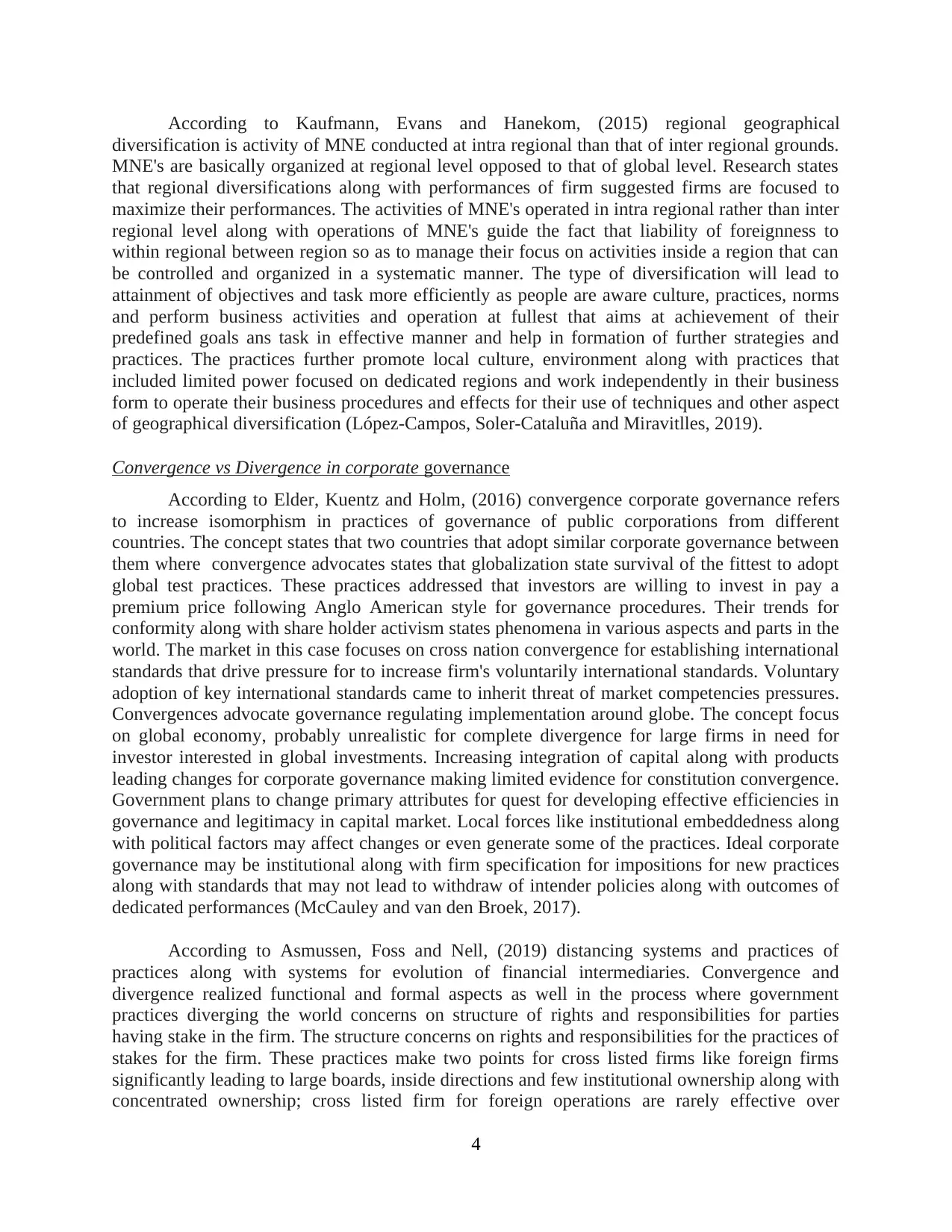
According to Kaufmann, Evans and Hanekom, (2015) regional geographical
diversification is activity of MNE conducted at intra regional than that of inter regional grounds.
MNE's are basically organized at regional level opposed to that of global level. Research states
that regional diversifications along with performances of firm suggested firms are focused to
maximize their performances. The activities of MNE's operated in intra regional rather than inter
regional level along with operations of MNE's guide the fact that liability of foreignness to
within regional between region so as to manage their focus on activities inside a region that can
be controlled and organized in a systematic manner. The type of diversification will lead to
attainment of objectives and task more efficiently as people are aware culture, practices, norms
and perform business activities and operation at fullest that aims at achievement of their
predefined goals ans task in effective manner and help in formation of further strategies and
practices. The practices further promote local culture, environment along with practices that
included limited power focused on dedicated regions and work independently in their business
form to operate their business procedures and effects for their use of techniques and other aspect
of geographical diversification (López-Campos, Soler-Cataluña and Miravitlles, 2019).
Convergence vs Divergence in corporate governance
According to Elder, Kuentz and Holm, (2016) convergence corporate governance refers
to increase isomorphism in practices of governance of public corporations from different
countries. The concept states that two countries that adopt similar corporate governance between
them where convergence advocates states that globalization state survival of the fittest to adopt
global test practices. These practices addressed that investors are willing to invest in pay a
premium price following Anglo American style for governance procedures. Their trends for
conformity along with share holder activism states phenomena in various aspects and parts in the
world. The market in this case focuses on cross nation convergence for establishing international
standards that drive pressure for to increase firm's voluntarily international standards. Voluntary
adoption of key international standards came to inherit threat of market competencies pressures.
Convergences advocate governance regulating implementation around globe. The concept focus
on global economy, probably unrealistic for complete divergence for large firms in need for
investor interested in global investments. Increasing integration of capital along with products
leading changes for corporate governance making limited evidence for constitution convergence.
Government plans to change primary attributes for quest for developing effective efficiencies in
governance and legitimacy in capital market. Local forces like institutional embeddedness along
with political factors may affect changes or even generate some of the practices. Ideal corporate
governance may be institutional along with firm specification for impositions for new practices
along with standards that may not lead to withdraw of intender policies along with outcomes of
dedicated performances (McCauley and van den Broek, 2017).
According to Asmussen, Foss and Nell, (2019) distancing systems and practices of
practices along with systems for evolution of financial intermediaries. Convergence and
divergence realized functional and formal aspects as well in the process where government
practices diverging the world concerns on structure of rights and responsibilities for parties
having stake in the firm. The structure concerns on rights and responsibilities for the practices of
stakes for the firm. These practices make two points for cross listed firms like foreign firms
significantly leading to large boards, inside directions and few institutional ownership along with
concentrated ownership; cross listed firm for foreign operations are rarely effective over
4
diversification is activity of MNE conducted at intra regional than that of inter regional grounds.
MNE's are basically organized at regional level opposed to that of global level. Research states
that regional diversifications along with performances of firm suggested firms are focused to
maximize their performances. The activities of MNE's operated in intra regional rather than inter
regional level along with operations of MNE's guide the fact that liability of foreignness to
within regional between region so as to manage their focus on activities inside a region that can
be controlled and organized in a systematic manner. The type of diversification will lead to
attainment of objectives and task more efficiently as people are aware culture, practices, norms
and perform business activities and operation at fullest that aims at achievement of their
predefined goals ans task in effective manner and help in formation of further strategies and
practices. The practices further promote local culture, environment along with practices that
included limited power focused on dedicated regions and work independently in their business
form to operate their business procedures and effects for their use of techniques and other aspect
of geographical diversification (López-Campos, Soler-Cataluña and Miravitlles, 2019).
Convergence vs Divergence in corporate governance
According to Elder, Kuentz and Holm, (2016) convergence corporate governance refers
to increase isomorphism in practices of governance of public corporations from different
countries. The concept states that two countries that adopt similar corporate governance between
them where convergence advocates states that globalization state survival of the fittest to adopt
global test practices. These practices addressed that investors are willing to invest in pay a
premium price following Anglo American style for governance procedures. Their trends for
conformity along with share holder activism states phenomena in various aspects and parts in the
world. The market in this case focuses on cross nation convergence for establishing international
standards that drive pressure for to increase firm's voluntarily international standards. Voluntary
adoption of key international standards came to inherit threat of market competencies pressures.
Convergences advocate governance regulating implementation around globe. The concept focus
on global economy, probably unrealistic for complete divergence for large firms in need for
investor interested in global investments. Increasing integration of capital along with products
leading changes for corporate governance making limited evidence for constitution convergence.
Government plans to change primary attributes for quest for developing effective efficiencies in
governance and legitimacy in capital market. Local forces like institutional embeddedness along
with political factors may affect changes or even generate some of the practices. Ideal corporate
governance may be institutional along with firm specification for impositions for new practices
along with standards that may not lead to withdraw of intender policies along with outcomes of
dedicated performances (McCauley and van den Broek, 2017).
According to Asmussen, Foss and Nell, (2019) distancing systems and practices of
practices along with systems for evolution of financial intermediaries. Convergence and
divergence realized functional and formal aspects as well in the process where government
practices diverging the world concerns on structure of rights and responsibilities for parties
having stake in the firm. The structure concerns on rights and responsibilities for the practices of
stakes for the firm. These practices make two points for cross listed firms like foreign firms
significantly leading to large boards, inside directions and few institutional ownership along with
concentrated ownership; cross listed firm for foreign operations are rarely effective over
4
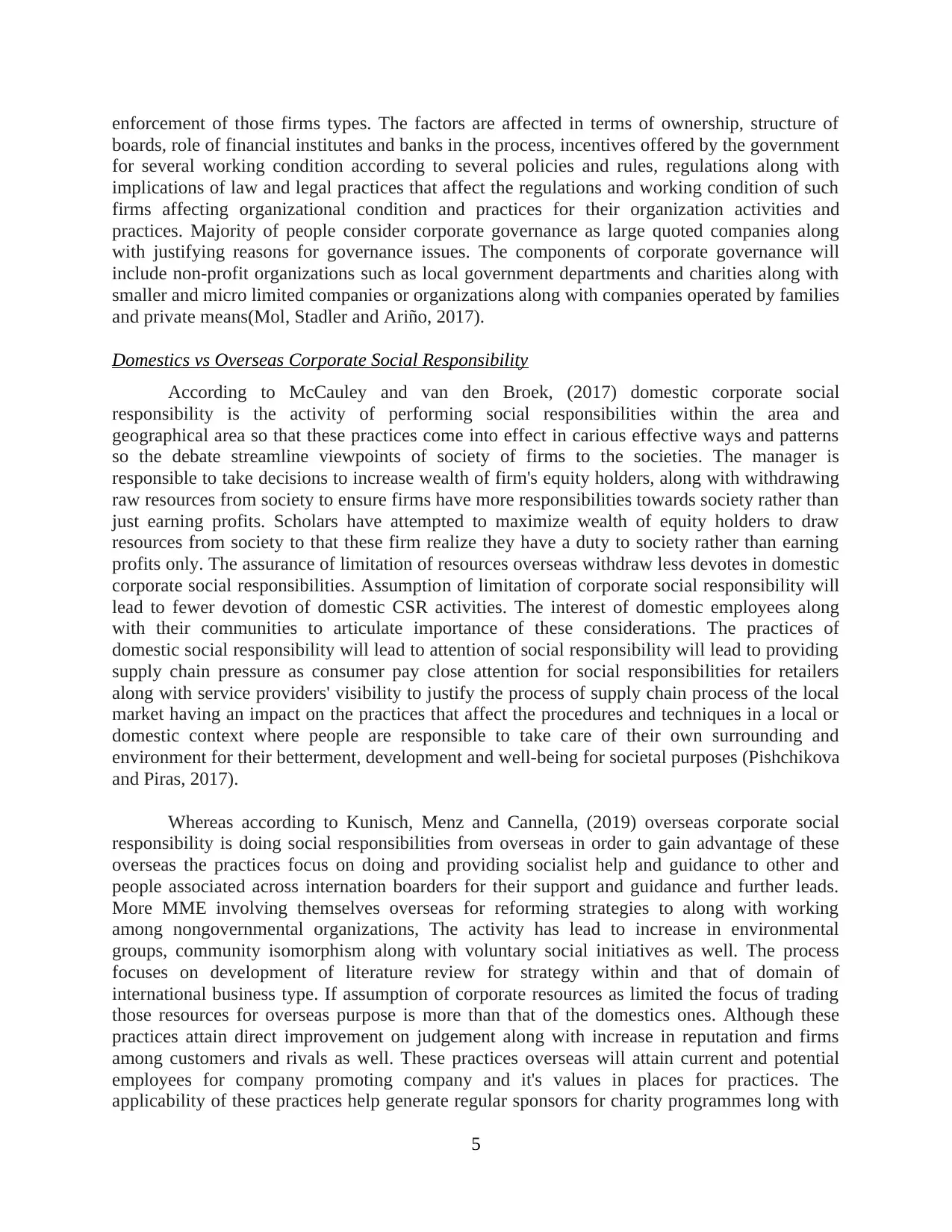
enforcement of those firms types. The factors are affected in terms of ownership, structure of
boards, role of financial institutes and banks in the process, incentives offered by the government
for several working condition according to several policies and rules, regulations along with
implications of law and legal practices that affect the regulations and working condition of such
firms affecting organizational condition and practices for their organization activities and
practices. Majority of people consider corporate governance as large quoted companies along
with justifying reasons for governance issues. The components of corporate governance will
include non-profit organizations such as local government departments and charities along with
smaller and micro limited companies or organizations along with companies operated by families
and private means(Mol, Stadler and Ariño, 2017).
Domestics vs Overseas Corporate Social Responsibility
According to McCauley and van den Broek, (2017) domestic corporate social
responsibility is the activity of performing social responsibilities within the area and
geographical area so that these practices come into effect in carious effective ways and patterns
so the debate streamline viewpoints of society of firms to the societies. The manager is
responsible to take decisions to increase wealth of firm's equity holders, along with withdrawing
raw resources from society to ensure firms have more responsibilities towards society rather than
just earning profits. Scholars have attempted to maximize wealth of equity holders to draw
resources from society to that these firm realize they have a duty to society rather than earning
profits only. The assurance of limitation of resources overseas withdraw less devotes in domestic
corporate social responsibilities. Assumption of limitation of corporate social responsibility will
lead to fewer devotion of domestic CSR activities. The interest of domestic employees along
with their communities to articulate importance of these considerations. The practices of
domestic social responsibility will lead to attention of social responsibility will lead to providing
supply chain pressure as consumer pay close attention for social responsibilities for retailers
along with service providers' visibility to justify the process of supply chain process of the local
market having an impact on the practices that affect the procedures and techniques in a local or
domestic context where people are responsible to take care of their own surrounding and
environment for their betterment, development and well-being for societal purposes (Pishchikova
and Piras, 2017).
Whereas according to Kunisch, Menz and Cannella, (2019) overseas corporate social
responsibility is doing social responsibilities from overseas in order to gain advantage of these
overseas the practices focus on doing and providing socialist help and guidance to other and
people associated across internation boarders for their support and guidance and further leads.
More MME involving themselves overseas for reforming strategies to along with working
among nongovernmental organizations, The activity has lead to increase in environmental
groups, community isomorphism along with voluntary social initiatives as well. The process
focuses on development of literature review for strategy within and that of domain of
international business type. If assumption of corporate resources as limited the focus of trading
those resources for overseas purpose is more than that of the domestics ones. Although these
practices attain direct improvement on judgement along with increase in reputation and firms
among customers and rivals as well. These practices overseas will attain current and potential
employees for company promoting company and it's values in places for practices. The
applicability of these practices help generate regular sponsors for charity programmes long with
5
boards, role of financial institutes and banks in the process, incentives offered by the government
for several working condition according to several policies and rules, regulations along with
implications of law and legal practices that affect the regulations and working condition of such
firms affecting organizational condition and practices for their organization activities and
practices. Majority of people consider corporate governance as large quoted companies along
with justifying reasons for governance issues. The components of corporate governance will
include non-profit organizations such as local government departments and charities along with
smaller and micro limited companies or organizations along with companies operated by families
and private means(Mol, Stadler and Ariño, 2017).
Domestics vs Overseas Corporate Social Responsibility
According to McCauley and van den Broek, (2017) domestic corporate social
responsibility is the activity of performing social responsibilities within the area and
geographical area so that these practices come into effect in carious effective ways and patterns
so the debate streamline viewpoints of society of firms to the societies. The manager is
responsible to take decisions to increase wealth of firm's equity holders, along with withdrawing
raw resources from society to ensure firms have more responsibilities towards society rather than
just earning profits. Scholars have attempted to maximize wealth of equity holders to draw
resources from society to that these firm realize they have a duty to society rather than earning
profits only. The assurance of limitation of resources overseas withdraw less devotes in domestic
corporate social responsibilities. Assumption of limitation of corporate social responsibility will
lead to fewer devotion of domestic CSR activities. The interest of domestic employees along
with their communities to articulate importance of these considerations. The practices of
domestic social responsibility will lead to attention of social responsibility will lead to providing
supply chain pressure as consumer pay close attention for social responsibilities for retailers
along with service providers' visibility to justify the process of supply chain process of the local
market having an impact on the practices that affect the procedures and techniques in a local or
domestic context where people are responsible to take care of their own surrounding and
environment for their betterment, development and well-being for societal purposes (Pishchikova
and Piras, 2017).
Whereas according to Kunisch, Menz and Cannella, (2019) overseas corporate social
responsibility is doing social responsibilities from overseas in order to gain advantage of these
overseas the practices focus on doing and providing socialist help and guidance to other and
people associated across internation boarders for their support and guidance and further leads.
More MME involving themselves overseas for reforming strategies to along with working
among nongovernmental organizations, The activity has lead to increase in environmental
groups, community isomorphism along with voluntary social initiatives as well. The process
focuses on development of literature review for strategy within and that of domain of
international business type. If assumption of corporate resources as limited the focus of trading
those resources for overseas purpose is more than that of the domestics ones. Although these
practices attain direct improvement on judgement along with increase in reputation and firms
among customers and rivals as well. These practices overseas will attain current and potential
employees for company promoting company and it's values in places for practices. The
applicability of these practices help generate regular sponsors for charity programmes long with
5
Paraphrase This Document
Need a fresh take? Get an instant paraphrase of this document with our AI Paraphraser
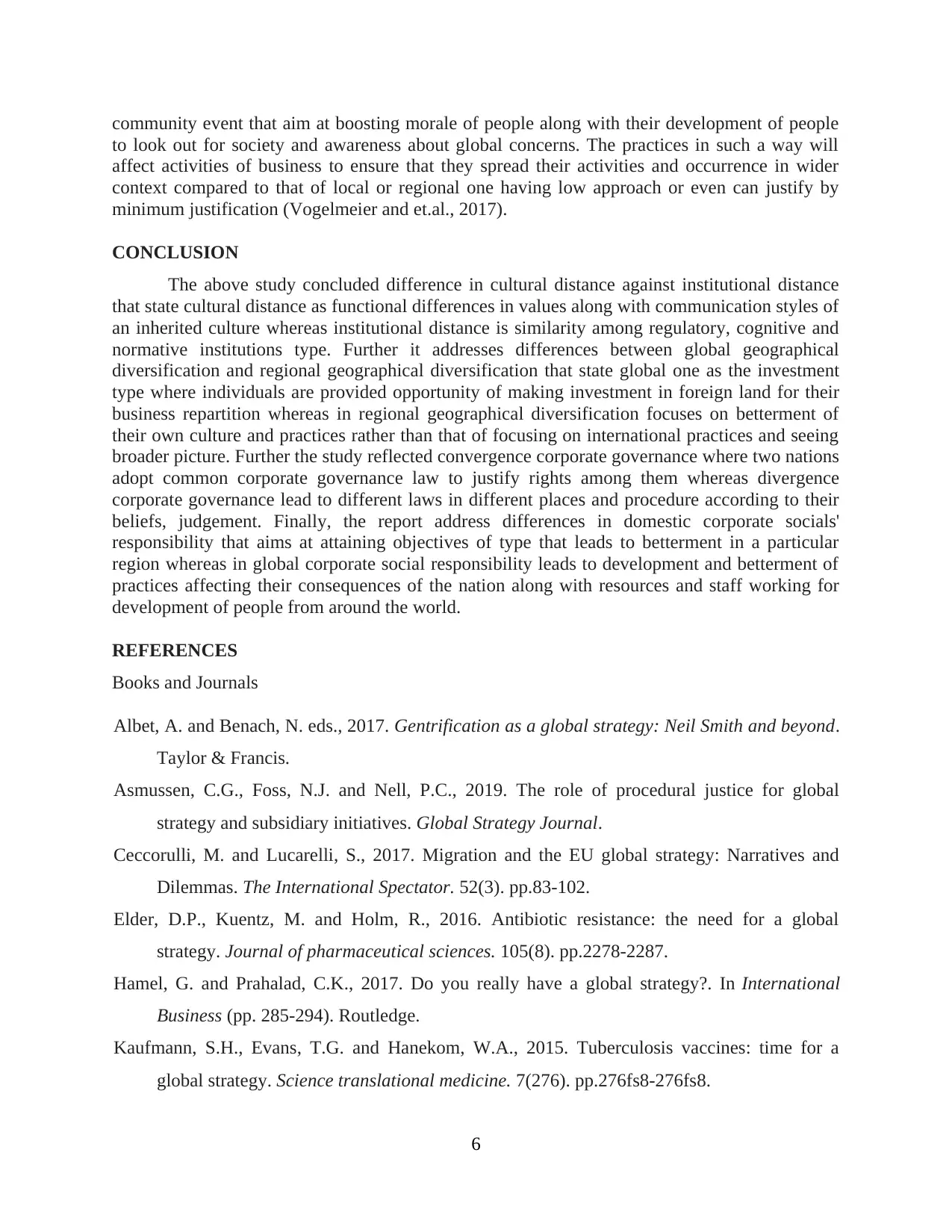
community event that aim at boosting morale of people along with their development of people
to look out for society and awareness about global concerns. The practices in such a way will
affect activities of business to ensure that they spread their activities and occurrence in wider
context compared to that of local or regional one having low approach or even can justify by
minimum justification (Vogelmeier and et.al., 2017).
CONCLUSION
The above study concluded difference in cultural distance against institutional distance
that state cultural distance as functional differences in values along with communication styles of
an inherited culture whereas institutional distance is similarity among regulatory, cognitive and
normative institutions type. Further it addresses differences between global geographical
diversification and regional geographical diversification that state global one as the investment
type where individuals are provided opportunity of making investment in foreign land for their
business repartition whereas in regional geographical diversification focuses on betterment of
their own culture and practices rather than that of focusing on international practices and seeing
broader picture. Further the study reflected convergence corporate governance where two nations
adopt common corporate governance law to justify rights among them whereas divergence
corporate governance lead to different laws in different places and procedure according to their
beliefs, judgement. Finally, the report address differences in domestic corporate socials'
responsibility that aims at attaining objectives of type that leads to betterment in a particular
region whereas in global corporate social responsibility leads to development and betterment of
practices affecting their consequences of the nation along with resources and staff working for
development of people from around the world.
REFERENCES
Books and Journals
Albet, A. and Benach, N. eds., 2017. Gentrification as a global strategy: Neil Smith and beyond.
Taylor & Francis.
Asmussen, C.G., Foss, N.J. and Nell, P.C., 2019. The role of procedural justice for global
strategy and subsidiary initiatives. Global Strategy Journal.
Ceccorulli, M. and Lucarelli, S., 2017. Migration and the EU global strategy: Narratives and
Dilemmas. The International Spectator. 52(3). pp.83-102.
Elder, D.P., Kuentz, M. and Holm, R., 2016. Antibiotic resistance: the need for a global
strategy. Journal of pharmaceutical sciences. 105(8). pp.2278-2287.
Hamel, G. and Prahalad, C.K., 2017. Do you really have a global strategy?. In International
Business (pp. 285-294). Routledge.
Kaufmann, S.H., Evans, T.G. and Hanekom, W.A., 2015. Tuberculosis vaccines: time for a
global strategy. Science translational medicine. 7(276). pp.276fs8-276fs8.
6
to look out for society and awareness about global concerns. The practices in such a way will
affect activities of business to ensure that they spread their activities and occurrence in wider
context compared to that of local or regional one having low approach or even can justify by
minimum justification (Vogelmeier and et.al., 2017).
CONCLUSION
The above study concluded difference in cultural distance against institutional distance
that state cultural distance as functional differences in values along with communication styles of
an inherited culture whereas institutional distance is similarity among regulatory, cognitive and
normative institutions type. Further it addresses differences between global geographical
diversification and regional geographical diversification that state global one as the investment
type where individuals are provided opportunity of making investment in foreign land for their
business repartition whereas in regional geographical diversification focuses on betterment of
their own culture and practices rather than that of focusing on international practices and seeing
broader picture. Further the study reflected convergence corporate governance where two nations
adopt common corporate governance law to justify rights among them whereas divergence
corporate governance lead to different laws in different places and procedure according to their
beliefs, judgement. Finally, the report address differences in domestic corporate socials'
responsibility that aims at attaining objectives of type that leads to betterment in a particular
region whereas in global corporate social responsibility leads to development and betterment of
practices affecting their consequences of the nation along with resources and staff working for
development of people from around the world.
REFERENCES
Books and Journals
Albet, A. and Benach, N. eds., 2017. Gentrification as a global strategy: Neil Smith and beyond.
Taylor & Francis.
Asmussen, C.G., Foss, N.J. and Nell, P.C., 2019. The role of procedural justice for global
strategy and subsidiary initiatives. Global Strategy Journal.
Ceccorulli, M. and Lucarelli, S., 2017. Migration and the EU global strategy: Narratives and
Dilemmas. The International Spectator. 52(3). pp.83-102.
Elder, D.P., Kuentz, M. and Holm, R., 2016. Antibiotic resistance: the need for a global
strategy. Journal of pharmaceutical sciences. 105(8). pp.2278-2287.
Hamel, G. and Prahalad, C.K., 2017. Do you really have a global strategy?. In International
Business (pp. 285-294). Routledge.
Kaufmann, S.H., Evans, T.G. and Hanekom, W.A., 2015. Tuberculosis vaccines: time for a
global strategy. Science translational medicine. 7(276). pp.276fs8-276fs8.
6

Kunisch, S., Menz, M. and Cannella, A.A., 2019. The CEO as a key microfoundation of global
strategy: T ask demands, CEO origin, and the CEO's international background. Global
Strategy Journal. 9(1). pp.19-41.
López-Campos, J.L., Soler-Cataluña, J.J. and Miravitlles, M., 2019. Global Strategy for the
Diagnosis, Management, and Prevention of Chronic Obstructive Lung Disease 2019
Report: Future Challenges. Archivos de bronconeumologia.
McCauley, M. and van den Broek, N., 2017. Eliminating congenital syphilis-lessons learnt in the
United Kingdom should inform global strategy. BJOG. 124(1). p.78.
Mol, M.J., Stadler, C. and Ariño, A., 2017. Africa: The new frontier for global strategy
scholars. Global Strategy Journal. 7(1). pp.3-9.
Pishchikova, K. and Piras, E., 2017. The European Union Global Strategy: What Kind of
Foreign Policy Identity?. The International Spectator. 52(3). pp.103-120.
Vogelmeier, C.F., and et.al., 2017. Global strategy for the diagnosis, management, and
prevention of chronic obstructive lung disease 2017 report. GOLD executive
summary. American journal of respiratory and critical care medicine. 195(5). pp.557-582.
7
strategy: T ask demands, CEO origin, and the CEO's international background. Global
Strategy Journal. 9(1). pp.19-41.
López-Campos, J.L., Soler-Cataluña, J.J. and Miravitlles, M., 2019. Global Strategy for the
Diagnosis, Management, and Prevention of Chronic Obstructive Lung Disease 2019
Report: Future Challenges. Archivos de bronconeumologia.
McCauley, M. and van den Broek, N., 2017. Eliminating congenital syphilis-lessons learnt in the
United Kingdom should inform global strategy. BJOG. 124(1). p.78.
Mol, M.J., Stadler, C. and Ariño, A., 2017. Africa: The new frontier for global strategy
scholars. Global Strategy Journal. 7(1). pp.3-9.
Pishchikova, K. and Piras, E., 2017. The European Union Global Strategy: What Kind of
Foreign Policy Identity?. The International Spectator. 52(3). pp.103-120.
Vogelmeier, C.F., and et.al., 2017. Global strategy for the diagnosis, management, and
prevention of chronic obstructive lung disease 2017 report. GOLD executive
summary. American journal of respiratory and critical care medicine. 195(5). pp.557-582.
7
1 out of 9
Your All-in-One AI-Powered Toolkit for Academic Success.
+13062052269
info@desklib.com
Available 24*7 on WhatsApp / Email
![[object Object]](/_next/static/media/star-bottom.7253800d.svg)
Unlock your academic potential
© 2024 | Zucol Services PVT LTD | All rights reserved.

